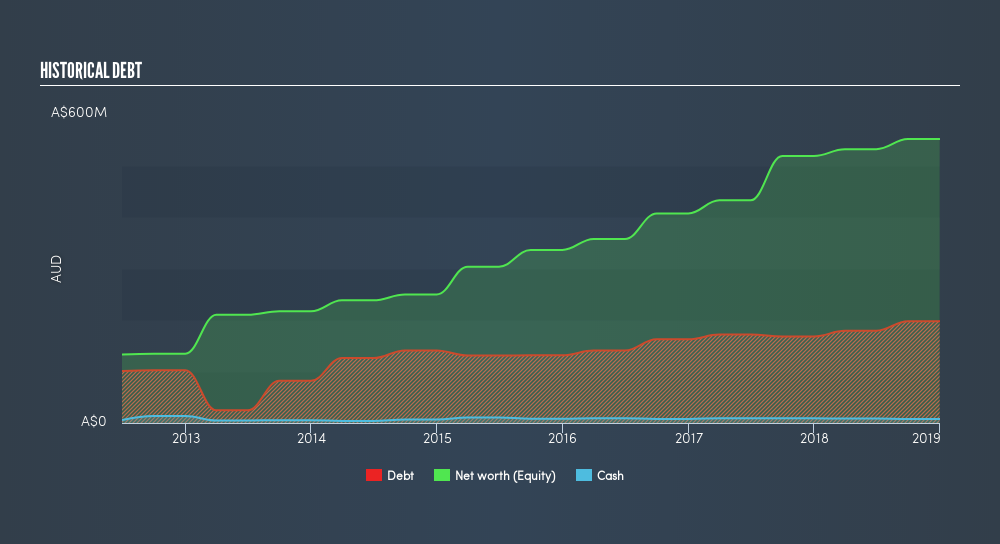
Arena REIT is a AU$748m small-cap, real estate investment trust (REIT) based in Melbourne, Australia. REITs own and operate income-generating property and adhere to a different set of regulations. This impacts how ARF’s business operates and also how we should analyse its stock. In this commentary, I'll take you through some of the things I look at when assessing ARF.
Check out our latest analysis for Arena REIT
A common financial term REIT investors should know is Funds from Operations, or FFO for short, which is a REIT's main source of income from its portfolio of property, such as rent. FFO is a cleaner and more representative figure of how much ARF actually makes from its day-to-day operations, compared to net income, which can be affected by one-off activities or non-cash items such as depreciation. For ARF, its FFO of AU$34m makes up 77% of its gross profit, which means the majority of its earnings are high-quality and recurring.

In order to understand whether ARF has a healthy balance sheet, we have to look at a metric called FFO-to-total debt. This tells us how long it will take ARF to pay off its debt using its income from its main business activities, and gives us an insight into ARF’s ability to service its borrowings. With a ratio of 19%, the credit rating agency Standard & Poor would consider this as significantly high risk. This would take ARF 5.3 years to pay off using operating income alone. Given that long-term debt is a multi-year commitment this is not unusual, however, the longer it takes for a company to pay back debt, the higher the risk associated with that company.
Next, interest coverage ratio shows how many times ARF’s earnings can cover its annual interest payments. Usually the ratio is calculated using EBIT, but for REITs, it’s better to use FFO divided by net interest. This is similar to the above concept, but looks at the nearer-term obligations. With an interest coverage ratio of 6.22x, it’s safe to say ARF is generating an appropriate amount of cash from its borrowings.
I also use FFO to look at ARF's valuation relative to other REITs in Australia by using the price-to-FFO metric. This is conceptually the same as the price-to-earnings (PE) ratio, but as previously mentioned, FFO is more suitable. ARF's price-to-FFO is 22.13x, compared to the long-term industry average of 16.5x, meaning that it is overvalued.
Next Steps:
Arena REIT can bring diversification into your portfolio due to its unique REIT characteristics. Before you make a decision on the stock today, keep in mind I've only covered one metric in this article, the FFO, which is by no means comprehensive. I'd strongly recommend continuing your research on the following areas I believe are key fundamentals for ARF:
- Future Outlook: What are well-informed industry analysts predicting for ARF’s future growth? Take a look at our free research report of analyst consensus for ARF’s outlook.
- Valuation: What is ARF worth today? Is the stock undervalued, even when its growth outlook is factored into its intrinsic value? The intrinsic value infographic in our free research report helps visualize whether ARF is currently mispriced by the market.
- Other High-Performing Stocks: Are there other stocks that provide better prospects with proven track records? Explore our free list of these great stocks here.
We aim to bring you long-term focused research analysis driven by fundamental data. Note that our analysis may not factor in the latest price-sensitive company announcements or qualitative material.
If you spot an error that warrants correction, please contact the editor at editorial-team@simplywallst.com. This article by Simply Wall St is general in nature. It does not constitute a recommendation to buy or sell any stock, and does not take account of your objectives, or your financial situation. Simply Wall St has no position in the stocks mentioned. Thank you for reading.
About ASX:ARF
Arena REIT
An ASX200 listed property group that develops, owns and manages social infrastructure properties across Australia.
Good value with proven track record and pays a dividend.
Similar Companies
Market Insights
Community Narratives



